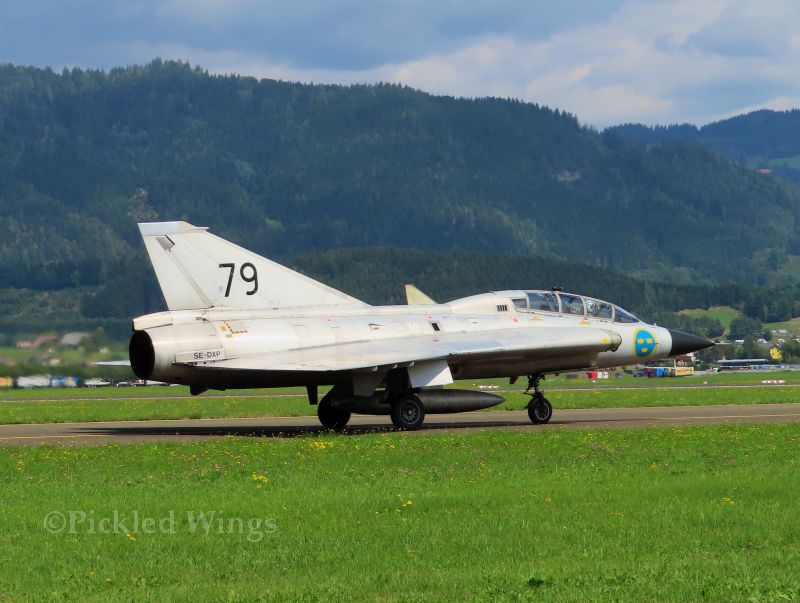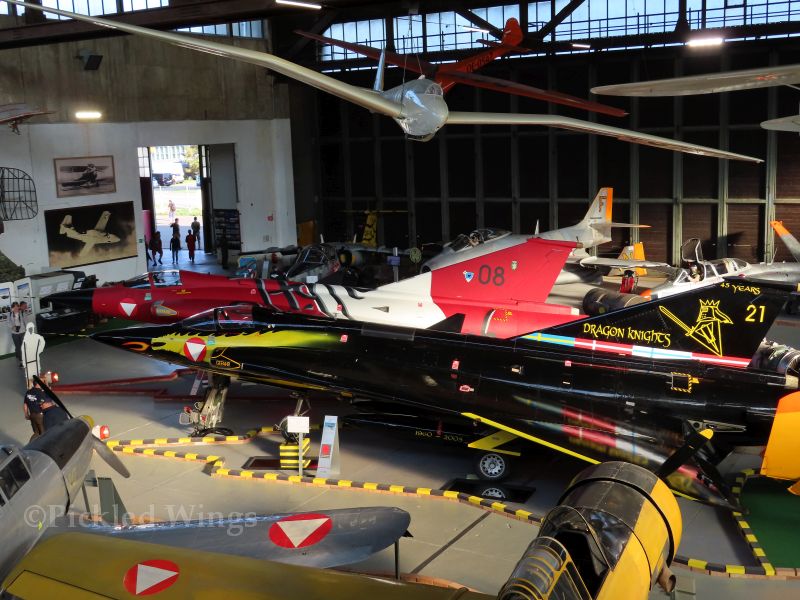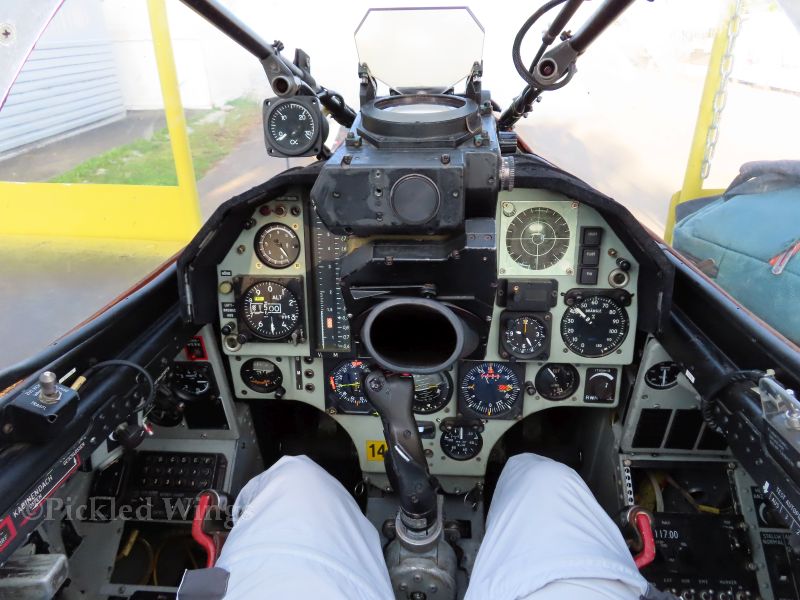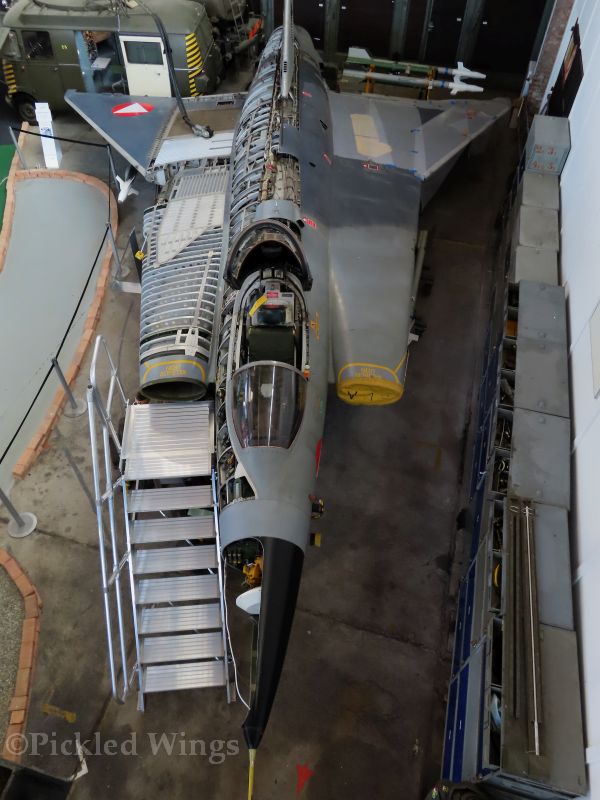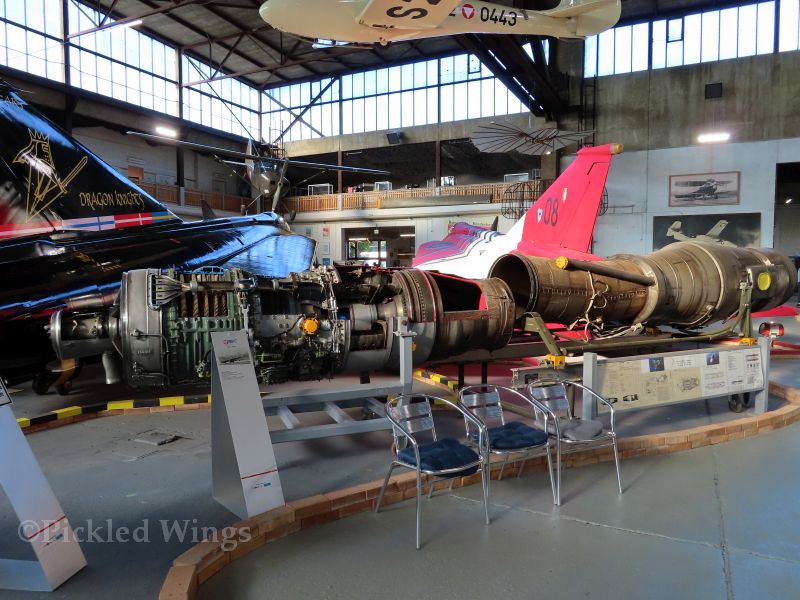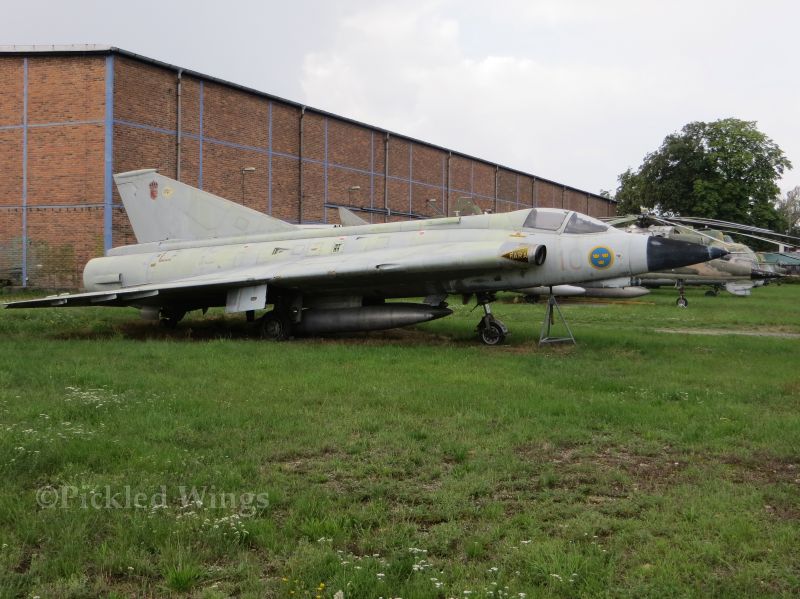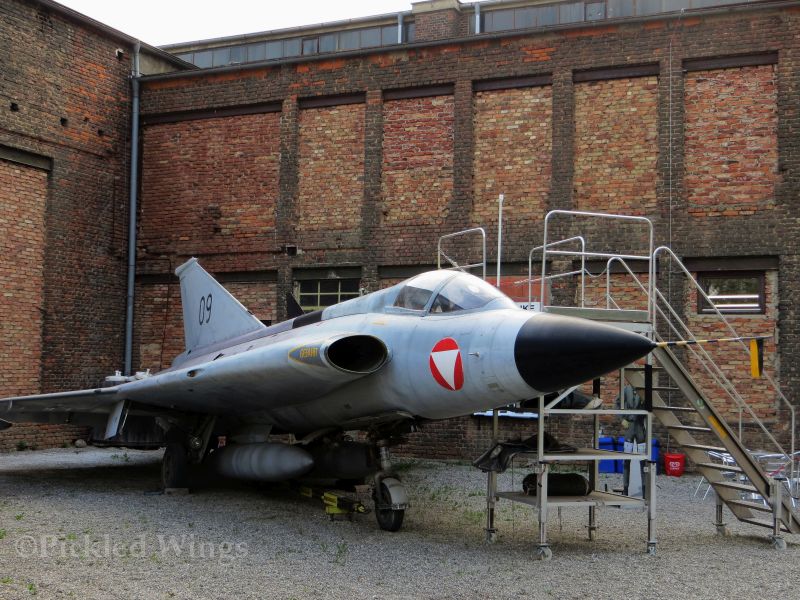Making the Leap
When Saab’s J-35 Draken (Dragon) entered Swedish air force service in 1960 after a rigorous design and development period, it caused a stir in the aviation world at large. Not only was the overall design a modern and unexpected departure from aircraft design norms of the period, the source of the aircraft was also something of a shock; that a relatively small company on the aviation landscape from a politically neutral nation would present the world with an all weather fighter capable of speeds exeding twice the speed of sound was unexpected indeed.
Saab was not unknown in jet fighter development prior to the J-35 Draken. Before the 1940s were finished, the company had developed the J-21R jet fighter from its J-21 piston powered fighter. The company’s first jet fighter designed as such from the ground up, the J-29 Tunnan, entered Swedish air force service in 1950 and was followed in 1956 by the J-32 Lansen.
The J-29 and J-32 were well regarded in the aviation world and stood as testament that Saab were capable of designing jet fighter aircraft which could match the capabilities of designs produced by larger, better known names in aviation. However, both designs were thoroughly conventional and mirrored aircraft design philosophies of their day.
By contrast, the J-35 Draken was a fully new design which showed that Saab could more than match what their contemporaries were producing and were not at all afraid to innovate.
A Unique Solution to Unique Requirements
At the height of the Cold War, incursions into domestic airspace by Soviet bomber aircraft were as much a concern to Sweden as they were to other western countries in the northern hemisphere. When the bombers became faster and flew higher, it was clear that the firmly subsonic J-29 and J-32 fighters were not up to the task of effectively intercepting them, supersonic speeds were essential. This fact was but one contributing factor to the Draken’s groundbreaking design.
Another key aspect that dictated the Draken’s design was Sweden’s own unique defensive doctrine. As a neutral country, Sweden shaped its defense network independent of other nations’ philosophies. As such, Sweden had rather different expectations of a combat aircraft than some other nations did.
Through the Cold War, Sweden became well known for requiring their combat aircraft to be able to use straight stretches of highway as improvised runways and for the aircraft to be fully supportable away from a fully equipped permanent base. This aspect dictated that the aircraft also have a relatively short take off and landing length.
The Draken would also need to be easily and competently maintainable by a small number of conscripted ground crew with possibly minimal training, so robust and relatively simple systems which could be easily accessed were a must. Also essential was that the aircraft spend a minimum amount of time on the ground between missions, the Draken had to be refueled and rearmed and put back into action in less than ten minutes.
From a strictly Swedish standpoint, the aircraft had to be compatible with the country’s Stridsledning integrated air combat management network. Known as “STRIL” for short, the network was composed of early warning radars and ground control centres which controlled and guided aircraft to their targets. The Draken would be a component of the “STRIL 60” network which was activated in 1960 and remained in service through to the early 1990s.
Of course, military considerations were not the only driving force in the Draken’s design. Sweden is not a large country and Saab was not a large company compared to many of its contemporaries; this meant that whatever else the company incorporated into the design, development and export potential had to be in the mix.
Needless to say, the Draken had a lot to live up to before it even left the designer’s drawing board.
The Dragon Takes Flight
The most striking external aspect of the Draken is its distinctive double delta wing configuration. A standard delta wing configuration is based on a triangle; the double delta, as the name implies, is based on a pair of triangles superimposed on each other. The principle behind the double delta arrangement is that two triangles of differing angles will provide the aircraft with better performance through a wider range of speeds than a standard delta wing would.
In the early 1950s, Saab proved the principles behind the double delta using a scaled down proof of concept aircraft known as the Saab 210. By late 1955, the first full scale Draken prototype had flown.
The aircraft was no less advanced in internal design. Very modern methods of parts fabrication were employed which allowed for a quite light airframe of modular construction. The airframe could be very logically disassembled into large structures for easy parts replacement in the field or offered as kits for assembly to export customers. As it was, only a handful of Drakens were ever assembled by non Swedish hands when 12 machines were assembled by Finland’s Valmet company from kits provided by Saab.
While an interceptor and air to air fighter in the main, the Draken was adapted to ground strike and reconnaissance roles. Versions exported to Denmark were optimized for air to ground strike with revised outer wing sections, improved electronic countermeasures and removal of the air to air radar.
For export versions, an alternative electronics system was offered in place of the STRIL 60 specific gear required by the Swedish versions of the aircraft. As STRIL was exclusive to Sweden, export customers had no use for equipment associated with it.
The Dragon’s Reign
The Draken’s military life lasted 45 years from its service debut in Sweden in 1960 to its final retirement in Austria in 2005. Beyond these two nations, the aircraft also served the air forces of Denmark and Finland.
Chile, Switzerland and Venezuela all took some interest in the Draken, though sales to them never materialized.
In military service, the Draken was everything it was intended to be; easy to maintain in spartan conditions away from fixed bases, quick to refuel and rearm between missions and possessing great development potential. Also, thanks to its Swedish built version of the British designed Rolls Royce Avon engine paired with a fully Swedish developed afterburner section, the Draken had the blistering speed so essential to the interceptor mission.
The J-35 Draken family isn’t a terribly complex one, though many members are rebuilt and refitted versions of other variants as Saab did buy some Drakens back from the Swedish military and refurbish them for export purposes. Here’s an overview of the J-35 Draken lineage:
J-35A:
This was the basic initial Swedish version which entered service in 1960. It was fitted with a French built radar as the Swedish one was not yet ready. The J-35 existed in both long and short fuselage versions due to variations in afterburner designs.
J-35B/BS:
The J-35B, which entered Swedish service in 1962, was equipped with a Swedish radar and fully integrated into the STRIL 60 network.
The J-35BS designation denotes the B versions sold to Finland.
J-35D/OE
Equipped with a new version of the Rolls Royce Avon engine, the D was the swiftest member of the Draken line. The D also incorporated lengthened air intakes for the engine and greater internal fuel capacity.
J-35OE was the designation given to 24 D models refurbished by Saab for sale to Austria in the mid 1980s.
J-35F/FS:
The J-35F, which entered service in 1965, was the most produced Draken version and had many improvements incorporated into it. The standard internal armament of two 30mm cannons was reduced to one to make room for additional avionics. The F version took the Hughes Falcon air to air missile of American design as its primary armament. Further improvements included the incorporation of an infrared targeting system and modifications to increase the radar’s resistance to electronic jamming.
J-35FS designated the F version sold to Finland.
J-35J:
An extensive rebuilding and modernization program of some F models in the mid to late 1980s resulted in the J model. Modifications included modern electronics and cannon, two extra weapons stations, increased internal fuel capacity along with airframe life extension modifications.
S-35E:
This was the reconnaissance version with a camera equipped nose in place of the radar. 60 of this version were built with roughly half that number being rebuilt from J-35D models.
SK-35C/CS:
The two seat trainer variation, SK-35C, was created by rebuilding 25 short fuselage J-35A variants.
SK-35CS was the designation of the Finnish air force variation of the trainer.
J-35XD:
This was the generic term for the much modified export versions which went to Denmark. Denmark used three variations of the Draken: the F-35 single seat fighter, the TF-35 two seat trainer and the RF-35 reconnaissance type.
J-35XS:
These were 12 aircraft of a roughly J-35F standard which were built in Finland. They were eventually upgraded to a J standard.
The Draken Today
The Draken has done quite well for itself in post military life with several airframes preserved in museums across Europe.
After their retirement from military service in 1993, several Danish Drakens were purchased and shipped to America to be kept airworthy for research flights and test pilot training. Those aircraft have since stopped flying and been put in storage or on display in museums.
As of 2022, two Drakens remain airworthy in Europe as part of the Swedish Air Force Historic Flight.
This link will take you to an article about the Draken at the Aces flying High website.
Another good article on the Draken can be found at the Afterburner Aviation Magazine website.
